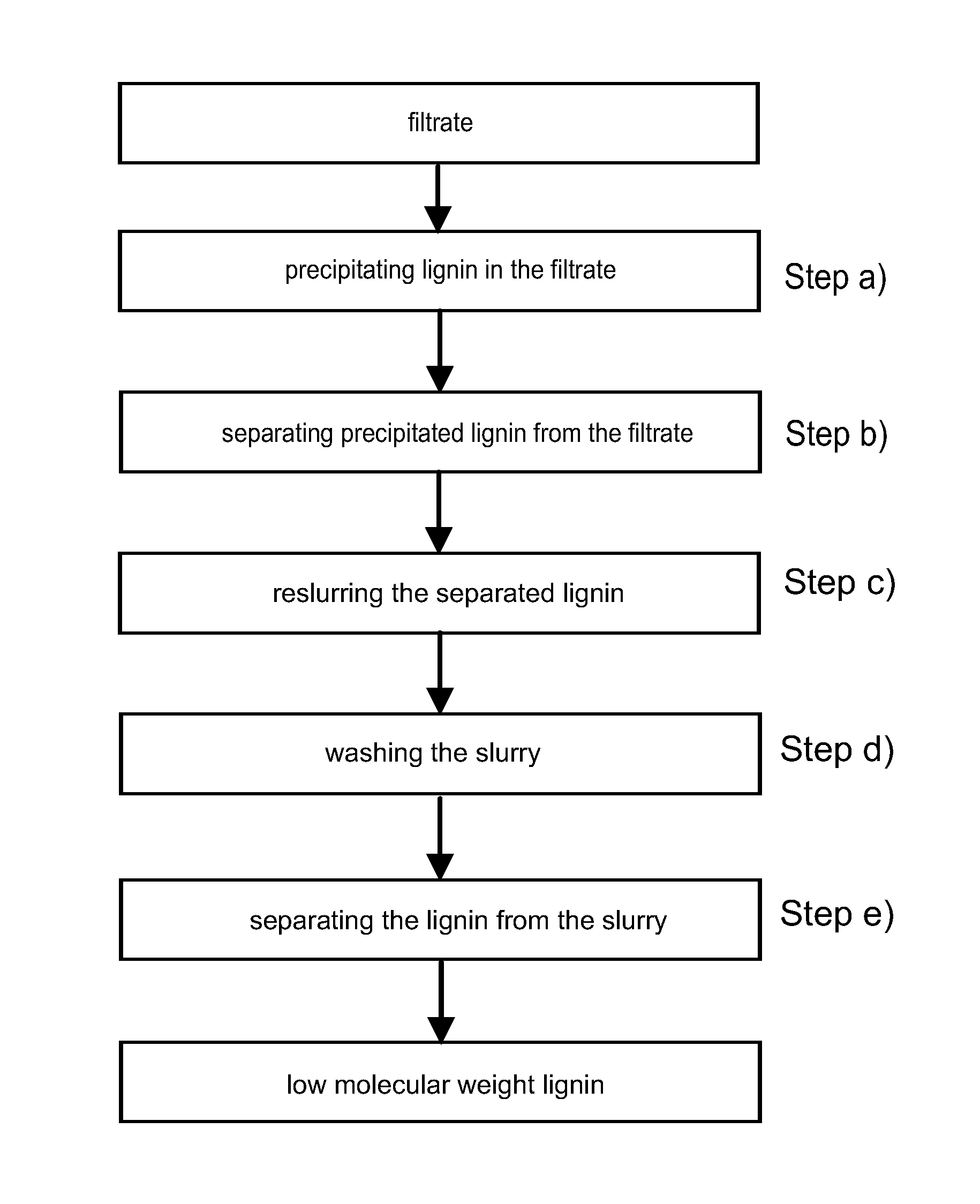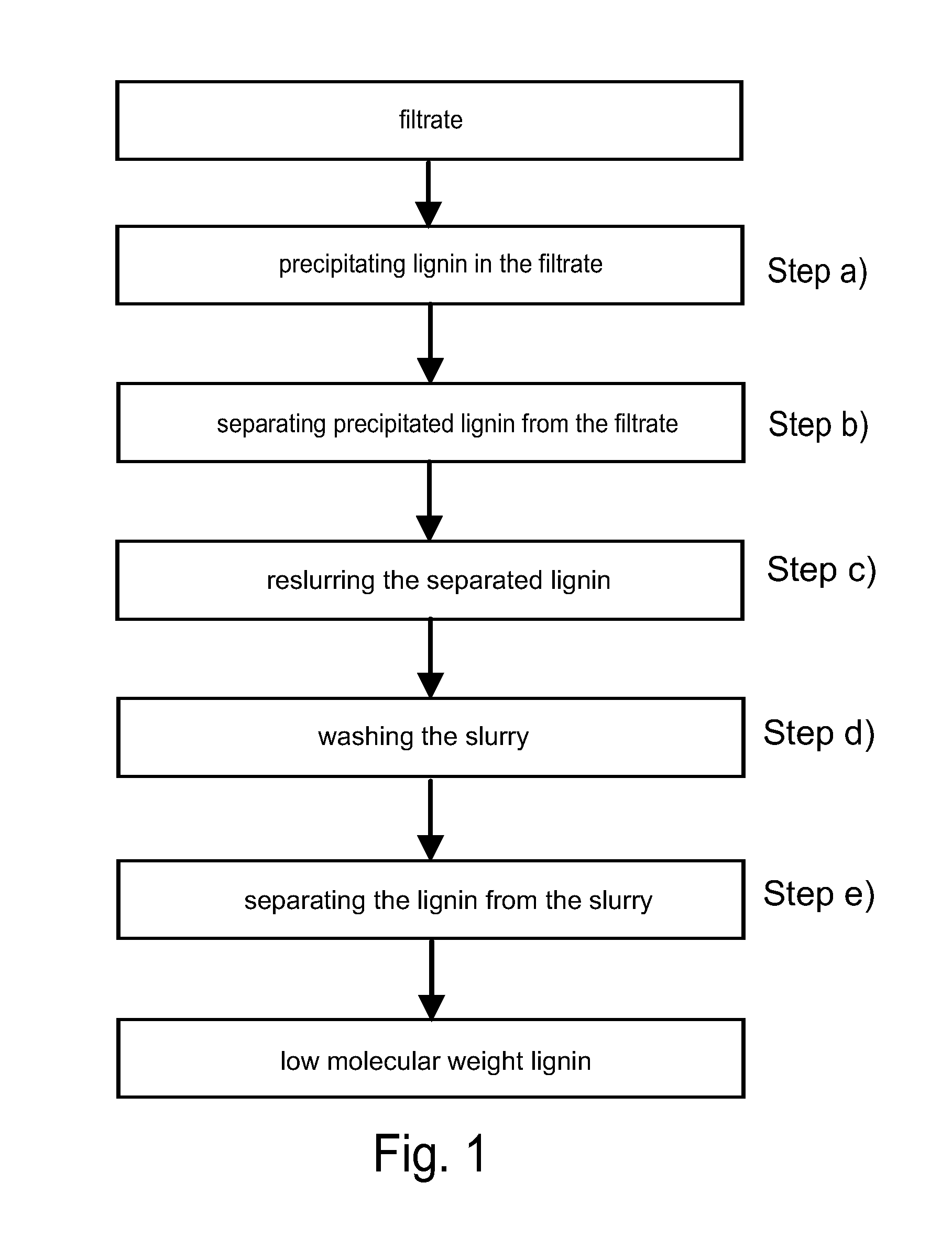Method for recovering low molecular weight lignin from a filtrate
a low molecular weight, lignin technology, applied in the field of low molecular weight lignin recovery from filtrates, can solve the problems of high cost, low yield of ultrafiltration process, etc., and achieve the effect of more solubl
- Summary
- Abstract
- Description
- Claims
- Application Information
AI Technical Summary
Benefits of technology
Problems solved by technology
Method used
Image
Examples
example 1
Recovering Low Molecular Weight Lignin from a Filtrate
[0058]In this example lignin was recovered in accordance with the embodiment presented in FIG. 1.
[0059]The filtrate from which the low molecular weight lignin was to be separated from was obtained from a process, where high molecular weight lignin is precipitated and separated from black liquor and where the lower molecular weight lignin is ending up in a resulting filtrate. The residual lignin content of the filtrate was about 14 weight-% of dry matter. The lignin content was determined by measuring the absorbance of a sample mixed with alkali with a UV-Vis spectrophotometer at 280 nm and by comparing the received value with a standard. The filtrate comprised lignin molecules, each of which had a molecular weight of 3000 g / mol or lower. The molecular weight was determined by size-exclusion-chromatography (Dionex).
[0060]This type of lignin was precipitated by adjusting the pH of the filtrate to 3-4 by adding sulphuric acid to the...
example 2
The Use of the Recovered Low Molecular Weight Lignin in the Production of a Binder Composition
[0066]In this example a binder composition was produced using the lignin recovered in accordance with example 1. The following components and their amounts were used:
concentrationamount (g)water179NaOH-I50%102HMW-lignin fraction97%146LMW-lignin fraction97%72phenol (polymerizable substance)90%123formaldehyde (crosslinking agent)40%370NaOH-II50%51
[0067]The HMW-lignin fraction (high molecular weight lignin fraction) was obtained from black liquor as a result of an ordinary lignin precipitation process as discussed above, which results in lignin cakes comprising high molecular weight lignin and in filtrate comprising low molecular weight lignin being formed. The LMW-lignin fraction (low molecular weight lignin fraction) comprised lignin recovered according to example 1.
[0068]Firstly, water, the first part of NaOH (NaOH-I) and HMW-lignin were mixed under heating such that a dispersion was formed...
example 3
Preparing an Adhesive Composition
[0070]In this example the binder composition produced in example 2 was used for the production of an adhesive composition. The binder composition was mixed with extenders, fillers, catalysts, additives, as examples of which e.g. starch, wood flour and hardener (e.g. tannin or carbonates) can be mentioned, thus forming the adhesive composition.
PUM
| Property | Measurement | Unit |
|---|---|---|
| temperature | aaaaa | aaaaa |
| delay time | aaaaa | aaaaa |
| temperature | aaaaa | aaaaa |
Abstract
Description
Claims
Application Information
 Login to View More
Login to View More - R&D
- Intellectual Property
- Life Sciences
- Materials
- Tech Scout
- Unparalleled Data Quality
- Higher Quality Content
- 60% Fewer Hallucinations
Browse by: Latest US Patents, China's latest patents, Technical Efficacy Thesaurus, Application Domain, Technology Topic, Popular Technical Reports.
© 2025 PatSnap. All rights reserved.Legal|Privacy policy|Modern Slavery Act Transparency Statement|Sitemap|About US| Contact US: help@patsnap.com


